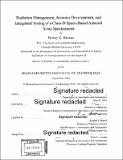| dc.contributor.advisor | Rebecca A. Masterson and Richard P. Binzel. | en_US |
| dc.contributor.author | Biswas, Pronoy K. (Pronoy Kumar) | en_US |
| dc.contributor.other | Massachusetts Institute of Technology. Department of Aeronautics and Astronautics. | en_US |
| dc.date.accessioned | 2017-02-22T19:01:11Z | |
| dc.date.available | 2017-02-22T19:01:11Z | |
| dc.date.copyright | 2016 | en_US |
| dc.date.issued | 2016 | en_US |
| dc.identifier.uri | http://hdl.handle.net/1721.1/107050 | |
| dc.description | Thesis: S.M., Massachusetts Institute of Technology, Department of Aeronautics and Astronautics, 2016. | en_US |
| dc.description | Cataloged from PDF version of thesis. | en_US |
| dc.description | Includes bibliographical references (pages 161-165). | en_US |
| dc.description.abstract | The Regolith X-ray Imaging Spectrometer (REXIS) is a student designed and built payload instrument aboard NASA's OSIRIS-REx asteroid sample return mission. The interplanetary target for this mission is a primitive asteroid known as Bennu that is believed to be relatively unchanged since the formation of the Solar System over 4.5 billion years ago. The primary goal of REXIS is to provide data to determine the elemental abundance composition of Bennu's surface through the measurement of X-ray fluorescence from Bennu's regolith. Achieving this goal requires the REXIS instrument to have an avionics system designed to operate the x-ray detectors, perform some preliminary processing of the x-ray events detected, and transfer this information to the main spacecraft computer for transmission to Earth. REXIS avionics accomplish these tasks using a mixture of commercial and spaceflight-grade hardware, reconfigurable Xilinx and Actel FPGAs, and a softcore MicroBlaze processor. Although the REXIS instrument is classified as a high-risk Class-D project by NASA, it must safely interface (in the manner of "do no harm") with the low-risk Class-B OSIRIS-REx spacecraft. Furthermore, REXIS must operate in the interplanetary space radiation environment of the OSIRIS-REx mission. This thesis details the REXIS avionics system and its novel features for collecting scientific x- ray data, interfacing safely with the OSIRIS-REx main spacecraft in spite of differing Class B/D risk postures, and robust operation in the interplanetary space radiation environment. Emphasis is placed on how the REXIS avionics design and radiation hazard mitigation features were implemented with significant budget and time constraints. | en_US |
| dc.description.statementofresponsibility | by Pronoy K. Biswas. | en_US |
| dc.format.extent | 165 pages | en_US |
| dc.language.iso | eng | en_US |
| dc.publisher | Massachusetts Institute of Technology | en_US |
| dc.rights | MIT theses are protected by copyright. They may be viewed, downloaded, or printed from this source but further reproduction or distribution in any format is prohibited without written permission. | en_US |
| dc.rights.uri | http://dspace.mit.edu/handle/1721.1/7582 | en_US |
| dc.subject | Aeronautics and Astronautics. | en_US |
| dc.title | Radiation management, avionics development, and integrated testing of a Class-D space-based asteroid X-ray spectrometer | en_US |
| dc.type | Thesis | en_US |
| dc.description.degree | S.M. | en_US |
| dc.contributor.department | Massachusetts Institute of Technology. Department of Aeronautics and Astronautics | |
| dc.identifier.oclc | 971021288 | en_US |
